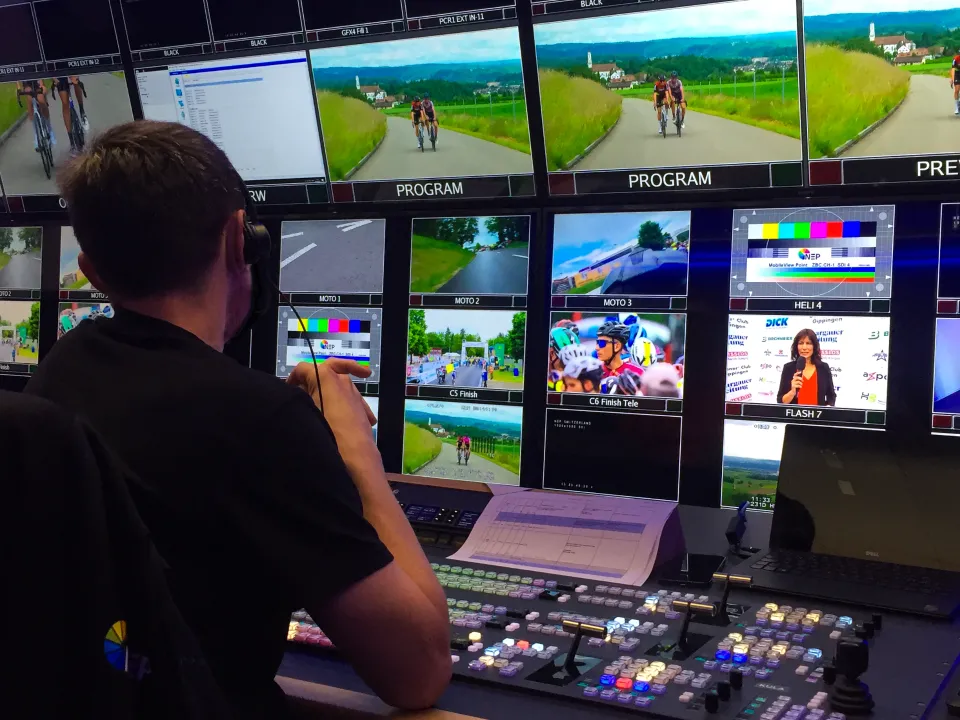How NEP Switzerland Powers Remote Productions with Medialooks Video Transport

As the demand for flexible, cost-efficient live production grows, broadcasters around the world are rethinking how they move video. NEP Switzerland, one of Europe’s leading broadcast service providers, has embraced this shift — using Medialooks Video Transport to bring live sports coverage from remote Swiss locations directly into their production control room near Zurich. The result is a reliable, low-latency workflow that delivers broadcast-quality results over public internet connections.
For more than 15 years, NEP Switzerland has been at the forefront of live broadcast production in one of Europe’s most technologically advanced markets. As part of NEP Group, one of the world’s largest broadcast and media services company, NEP Switzerland delivers a wide range of productions across football, ice hockey, and other sports — and increasingly relies on Medialooks Video Transport to make remote production more efficient and cost-effective.
“We are one of the biggest broadcast companies here in Switzerland,” says Christian Koseck, Director and Chief Operational Officer at NEP Switzerland. “Our main focus in Switzerland is on sports — football, ice hockey, and other events across the country.”
From early adoption to everyday use
NEP Switzerland has been using Video Transport for over five years, long before remote workflows became mainstream. “We started with a really early version — five to six years ago, even before COVID,” Christian Koseck recalls. “During the pandemic, we used it a lot for our TV shows, bringing in web guests with Video Transport. It was an easy and reliable alternative to Teams and other tools at that time.”
Today, Video Transport remains a key part of NEP’s remote production toolkit. “After COVID, we started using the Video Transport Server solution more and more for remote productions,” Christian Koseck explains. “We have our in-house production control in Switzerland, and cameras placed in the field — sometimes in very remote areas.”
Thanks to Switzerland’s strong internet infrastructure, these workflows are remarkably stable. “Most locations here can get a high and stable internet connection,” Christain Koseck says. “So it’s quite easy for us to use Video Transport to bring in our broadcast camera signals.”
Remote coverage across mountains and cities
One of NEP’s most remarkable productions using Video Transport took place in 2023. The project involved covering a world-record attempt for the longest passenger train — stretching nearly two kilometers and winding down a Swiss mountain.
“We used Video Transport for the whole production to transport the signals to our production center near Zurich,” says Christian Koseck. “Some of the cameras were placed on top of a mountain, and the only way to get the signal out was through an Air fiber link. Still, we were able to get a really stable video feed. That was impressive.”

The same approach is now used for endurance sports like triathlons and duathlons, where cameras are spread across kilometers of track. “It’s quite easy to deploy some Video Transport servers along the course with cameras and bring the signals into our headquarters,” Christian Koseck says.
Reliable and cost-efficient
In live broadcasting, cost efficiency is as critical as reliability — and that’s where Video Transport stands out. “The biggest value we get from Video Transport is that we can use regular hardware,” explains Christian Koseck. “You don’t have to invest in high-cost broadcast gear. You can use hardware you already have or even consumer-grade machines. Sometimes we use our graphics computers if we’re running low on hardware — they have the same specs and work perfectly.”
Even when working over public internet connections, NEP Switzerland often relies on Video Transport as the main signal path. “Normally we use it as the main transport,” Christian Koseck says. “When we produce via the public internet, we always communicate the advantages and disadvantages openly to the customer. Here, the customer has the opportunity to save on contribution costs, and the results are really good.”

In fact, reliability in the field has exceeded expectations. “We did three remote productions this year using Video Transport,” says Christian Koseck. “All of them went really well. The clients were very happy.”
A tool built for broadcast
Compared to other solutions, Medialooks’ focus on video transmission — rather than conferencing — makes all the difference. “With vMix or Teams, you can send video, but they are not dedicated to transport,” Koseck explains. “With Video Transport, you have a solution designed just for sending and receiving signals, with proper SDI input and output. It’s easy, it’s direct, and it works.”
Supporting the future of remote production
As the industry continues to evolve, NEP Switzerland sees software-defined, internet-based workflows as the future of live broadcast. “We’re always searching for good, cost-efficient solutions for our clients,” says Christian Koseck. “Video Transport helps us because we can reuse existing hardware and still deliver reliable, high-quality productions. It’s a simple, powerful solution that just works.”
About NEP Switzerland:
NEP Switzerland is a leading broadcast production company based near Zurich. As part of NEP Group, it provides comprehensive live production services for sports and entertainment events across Switzerland and Europe.
About Medialooks Video Transport:
Medialooks Video Transport (VT) enables real-time, low-latency video transmission over public internet using standard hardware. It’s trusted by broadcasters and production companies worldwide for remote, distributed, and cloud-based workflows.
